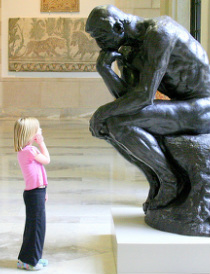I’m not sure I knew that art galleries even existed until I left home at sixteen and went to Teachers’ College. Mind you, back then I thought that spaghetti always came from a tin. But that’s another story.

prints of the Laughing Cavalier, the Red Boy and the Blue Boy in their velvet suits. And there were some painted pink roses on a sign which hung over the Formica dining table. “Christ is the unseen guest at every meal” it said unnervingly, “the silent listener to every conversation”.
Neither the paintings - or the ducks - were ever referred to as “art”. The question of who had created them, their purpose, or why they were displayed was never discussed.

I passed through the library foyer and under the mural innumerable times as a child. Each time something lurched inside me. It wasn’t just the size of the painting that affected me, or the desolation and suffering it depicted. It made me aware for the first time that pictures could open up worlds of experience, feeling and meaning far beyond the limits of my own small life. I already knew there were people called writers who could do this with words on a page. But I had not known that there were other people – artists - who could do this with paint on canvas.
Now as an adult I go to art exhibitions, and almost as often, I come away disappointed. I can admire an artist’s skill and technique or marvel at the patience and application which the work has required. I can enjoy a painting because it is beautiful, witty, novel, or clever. But I don’t often feel anything. I look. I read the catalogue. I wait to feel something. I look some more. I want to feel that lurch I first felt as a child looking up at Peter McIntyre’s painting. When the feeling doesn’t come, I wonder if the failing is in the art, or in me. Was I not exposed to art and art talk early enough? Is there some quality in art which I am blind to? Am I missing some vital aesthetic capacity? Or perhaps I just expect too much?
All this is to explain how delightful it was to walk into Boy Zone, a recent exhibition at the Refinery Artspace and find myself immediately, and without equivocation, engaged and moved. I did not expect this response to an exhibition which promised “An exploration into the art of Man Caves”.
Pete Hansen displayed small everyday objects – knuckle bones, photographs, bullets, a pair of glasses, a pocket knife, a box of matches, a pound note - within the compartments of beautifully constructed wooden boxes. Each of the larger objects in Robbie Burton’s exhibit,including an axe, a paint-stained cap, a Thermette, a strangely-shaped piece of drift wood - was accompanied by a simple description of its history and personal associations.
Richard Brett created an entire sitting room to display his extraordinary collection of U2 memorabilia – everything from posters and record covers to concert ticket butts, t-shirts and figurines.
The smooth wooden curves of a restored steam launch (1895) and a clinker dingy (1910) in Peter Murton’s space invited the touch, as did the hand tools arrayed on a work bench. Old, worn sails pinned to the wall looked like wings. The 1960 Volkswagen which Warren Gibbons’ had restored was all gussied up in metallic blue paint which glittered under the gallery lights.
So, what made the exhibition so affecting, especially to someone like me who seems impervious to the charms of so much gallery art?
It was partly the exhibition’s plainness and lack of pretention. These were real objects from the real world, elevated by the passion of their owners into something emblematic of the human urge to create beauty, to preserve our connection to the past and the people and places we have loved. Seeing these everyday objects - worn or lovingly restored – displayed in a white-walled gallery space made me appreciate them as precious and expressive artefacts.
But mostly I think I was moved by the fact that every loved object, every tool, every assemblage in the exhibition held a story. Robbie Burton’s notes on his exhibits made these stories explicit, simply and affectingly. But Pete Hansen’s quiet display boxes were brim-full of family and social histories too and Peter Murton says his boats, found burned or left to decay under hedges, “are like the lost fleet of New Zealand”.
As I strolled through the Boy Zone, I had the distinct impression that the gallery was full of people – particularly men – who would not normally have felt comfortable in an art gallery. Perhaps the reverse will also be true: art aficionados will be drawn to workshops and garages and sheds to admire there the unself-conscious display of objet d’art.
 RSS Feed
RSS Feed

